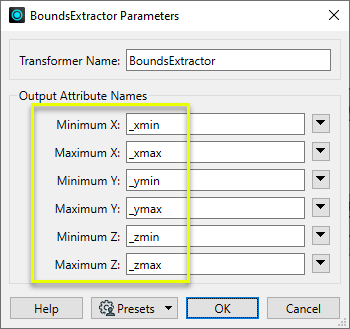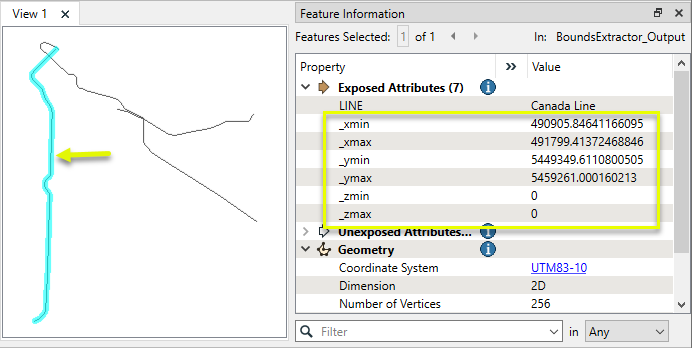Extracts a feature’s minimum and maximum coordinate values into attributes.
Typical Uses
-
Determining a feature’s extents as attribute values instead of geometry.
How does it work?
The BoundsExtractor receives features with any type of geometry and individually extracts their minimum and maximum x, y, and z coordinate values, storing them as attributes.
Where coordinate values do not exist (such as z values on 2D geometry or non-spatial features) a value of zero (0) is assigned.
To exclude an attribute, leave the parameter blank and it will not be added to the output features.
Feature geometry is unchanged.
Examples
In this example, we have a set of transit line features and wish to extract their bounds as attribute values.
Note that the features have Min and Max Extents values as geometry, but not attributes.

The features are routed into a BoundsExtractor.

In the parameters dialog, we keep the default attribute names provided.

The output features have new attributes containing the minimum and maximum coordinate values. Note that the features are 2D, and so the z values are zero (0).

Usage Notes
-
Point cloud extents need to be recalculated after some operations. Consider using the PointCloudPropertyExtractor and its Calculate and Update Extents parameter instead.
-
To extract minimum and maximum values on attributes, use the StatisticsCalculator.
Creating Boxes and Rectangles
Creating rectangular geometry is a common task. These transformers do so in a variety of ways.
|
Transformer |
Function |
|---|---|
|
Creates one or more new features with box geometry of a specific size and position (when Geometry Object is Box). |
|
|
Replaces an existing feature’s geometry with a box of a specific size and position. |
|
|
Creates one rectangle that encompasses all features received. |
|
|
Individually replaces the geometry of each feature with a rectangle that covers its extents. |
|
|
Individually replaces the geometry of each raster feature with a rectangle that covers its extents (with various Extents Type options). |
|
|
Extracts the coordinate values that describe an individual feature’s bounding box (or cube) and stores them as attributes. |
|
|
Creates a series of regularly-spaced rectangles that span the extent of all features received (when Type of Grid to Create is Polygons). |
|
|
Creates a series of regularly-spaced rectangles of a specific size and position (when Type of Grid to Create is Polygons). |
|
|
Tiler and RasterTiler |
Do not create actual rectangles, but chop features into a series of rectangular tiles, specified in a similar fashion to the 2DGridAccumulator. |
Configuration
Input Ports
This transformer accepts any feature.
Output Ports
Features with attributes containing minimum and maximum coordinate values.
Parameters
|
Minimum X |
Name the attribute to contain the minimum x value. |
|
Maximum X |
Name the attribute to contain the maximum x value. |
|
Minimum Y |
Name the attribute to contain the minimum y value. |
|
Maximum Y |
Name the attribute to contain the maximum y value. |
|
Minimum Z |
Name the attribute to contain the minimum z value. |
|
Maximum Z |
Name the attribute to contain the maximum z value. |
Editing Transformer Parameters
Using a set of menu options, transformer parameters can be assigned by referencing other elements in the workspace. More advanced functions, such as an advanced editor and an arithmetic editor, are also available in some transformers. To access a menu of these options, click  beside the applicable parameter. For more information, see Transformer Parameter Menu Options.
beside the applicable parameter. For more information, see Transformer Parameter Menu Options.
Defining Values
There are several ways to define a value for use in a Transformer. The simplest is to simply type in a value or string, which can include functions of various types such as attribute references, math and string functions, and workspace parameters. There are a number of tools and shortcuts that can assist in constructing values, generally available from the drop-down context menu adjacent to the value field.
Using the Text Editor
The Text Editor provides a convenient way to construct text strings (including regular expressions) from various data sources, such as attributes, parameters, and constants, where the result is used directly inside a parameter.
Using the Arithmetic Editor
The Arithmetic Editor provides a convenient way to construct math expressions from various data sources, such as attributes, parameters, and feature functions, where the result is used directly inside a parameter.
Conditional Values
Set values depending on one or more test conditions that either pass or fail.
Parameter Condition Definition Dialog
Content
Expressions and strings can include a number of functions, characters, parameters, and more.
When setting values - whether entered directly in a parameter or constructed using one of the editors - strings and expressions containing String, Math, Date/Time or FME Feature Functions will have those functions evaluated. Therefore, the names of these functions (in the form @<function_name>) should not be used as literal string values.
| These functions manipulate and format strings. | |
|
Special Characters |
A set of control characters is available in the Text Editor. |
| Math functions are available in both editors. | |
| Date/Time Functions | Date and time functions are available in the Text Editor. |
| These operators are available in the Arithmetic Editor. | |
| These return primarily feature-specific values. | |
| FME and workspace-specific parameters may be used. | |
| Creating and Modifying User Parameters | Create your own editable parameters. |
Dialog Options - Tables
Transformers with table-style parameters have additional tools for populating and manipulating values.
|
Row Reordering
|
Enabled once you have clicked on a row item. Choices include:
|
|
Cut, Copy, and Paste
|
Enabled once you have clicked on a row item. Choices include:
Cut, copy, and paste may be used within a transformer, or between transformers. |
|
Filter
|
Start typing a string, and the matrix will only display rows matching those characters. Searches all columns. This only affects the display of attributes within the transformer - it does not alter which attributes are output. |
|
Import
|
Import populates the table with a set of new attributes read from a dataset. Specific application varies between transformers. |
|
Reset/Refresh
|
Generally resets the table to its initial state, and may provide additional options to remove invalid entries. Behavior varies between transformers. |
Note: Not all tools are available in all transformers.
Reference
|
Processing Behavior |
|
|
Feature Holding |
No |
| Dependencies | None |
| Aliases | |
| History |
FME Community
The FME Community is the place for demos, how-tos, articles, FAQs, and more. Get answers to your questions, learn from other users, and suggest, vote, and comment on new features.
Search for all results about the BoundsExtractor on the FME Community.
Examples may contain information licensed under the Open Government Licence – Vancouver and/or the Open Government Licence – Canada.




